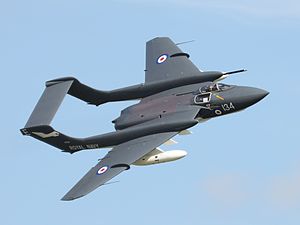
Back De Havilland Sea Vixen Afrikaans De Havilland Sea Vixen Czech De Havilland DH.110 Sea Vixen German De Havilland Sea Vixen Greek De Havilland DH.110 Sea Vixen Spanish دی هاویلند سی ویکسن Persian De Havilland D.H.110 Sea Vixen Finnish De Havilland Sea Vixen French De Havilland Sea Vixen Galician De Havilland Sea Vixen Hungarian
| DH.110 Sea Vixen | |
|---|---|
 The last airworthy Sea Vixen at RNAS Yeovilton, 2014 | |
| General information | |
| Type | Carrier-based fighter |
| National origin | United Kingdom |
| Manufacturer | de Havilland |
| Primary user | Royal Navy |
| Number built | 151 (including two DH110 prototypes and one Sea Vixen prototype) |
| History | |
| Introduction date | July 1959 |
| First flight | 26 September 1951[1] |
| Retired | 1972 |
The de Havilland DH.110 Sea Vixen is a British twin-engine, twin boom-tailed, two-seat, carrier-based fleet air-defence fighter flown by the Royal Navy's Fleet Air Arm from the 1950s to the early 1970s. The Sea Vixen was designed by the de Havilland Aircraft Company during the late 1940s at its Hatfield aircraft factory in Hertfordshire, developed from the company's earlier first generation jet fighters.[a] It was later called the Hawker Siddeley Sea Vixen after de Havilland was absorbed by the Hawker Siddeley Corporation in 1960.
The Sea Vixen had the distinction of being the first British two-seat combat aircraft to achieve supersonic speed, albeit not in level flight. Operating from British aircraft carriers, it was used in combat over Tanganyika and over Yemen during the Aden Emergency. In 1972, the Sea Vixen was phased out in favour of the American-made McDonnell Douglas Phantom FG.1 interceptor. There have been no flying Sea Vixens since 2017.
Cite error: There are <ref group=lower-alpha> tags or {{efn}} templates on this page, but the references will not show without a {{reflist|group=lower-alpha}} template or {{notelist}} template (see the help page).